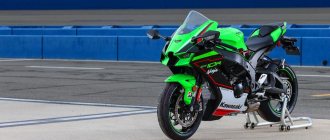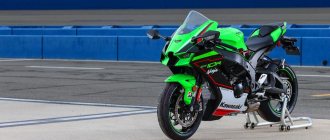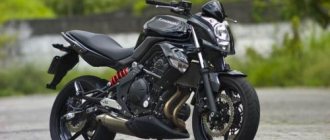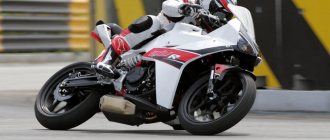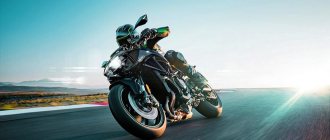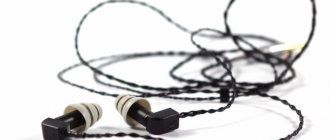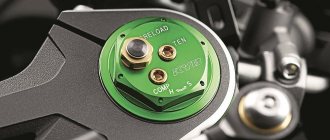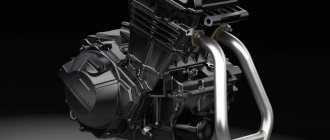Kawasaki Ninja ZX 6R abs 2018
The Kawasaki Ninja ZX 6R is Kawasaki's entry into the mid-size sportbike niche.
The Kawasaki Ninja ZX 6R has almost all the same features as its larger brethren, albeit on a slightly smaller scale. And it's not just about the looks: the manufacturer has installed a four-cylinder powerplant in a frame clad in a wind tunnel-tested body kit, and stuffed the resulting machine with the full complement of electronic components needed to keep it all in check. However, this does not mean that the 6R is suitable for beginners. Rather, it is a motorcycle that is taken for the first or second increase in cubic capacity, or, for example, as a second motorcycle for Sunday prowess. Let's take a closer look at it and decide what it is and why.
Kawasaki Ninja ZX 6R design
Kawasaki designed the Ninja ZX 6R to be a serious midsize sports machine, not just another pocket lighter. Therefore, it starts with a fairing very similar to the “face” of its older brother, the ZX-10R. The fairing has a low drag coefficient, and the low windshield forms an air pocket for a sporty landing, which is also favored by short clip-ons located flush with the upper crossbar.
Twin headlight "eyes" are recessed slightly into the fairing, and the front turn signals are integrated into the edges of the side panels in an attempt to reduce drag to a minimum. An air duct located in the center of the fairing provides direct air flow, and thanks to the ramming effect, the efficiency of air intake is significantly higher than that of engines with a conventional “breathing” system, with a corresponding increase in power. And of course, installing the radiator inside the capsule formed by the side panels and the front fairing allows you to effectively remove heat from it, removing warm air behind the body panels.
The 17-liter tank defines the top contours of the bike, tapering downwards to form a knee-hugging pocket. The tail is upturned in contrast to the low nose that is typical of modern supersports, and although the tail section has a passenger seat and a pair of folding footpegs attached to the subframe, the rear design is more about aerodynamics than passenger comfort.
The design of the mudguard is quite controversial; perhaps a regular wing-hugger would be a better solution. Well, families of customizers need to eat something...
Kawasaki 636
Bright and interesting, this motorcycle has gained popularity among motorsports enthusiasts for a reason. The Kawasaki ZX-6R (636) is power hidden under an elegant design.
Although this is not the newest car, it will remain a worthy competitor to new sports class products for a long time.
Appearance
The design of the Kawasaki ZX-6R (636), although elegant, is still bright and aggressive. The factory light green paint suits the motorcycle especially well, making it look sportier. Wheels are typical for the class. The seating position is high, and the tank is located so that it is convenient to lie on it if necessary.
Comfort
When it comes to sporty riding, the Kawasaki ZX-6R (636) is certainly comfortable. But for a beginner who has just passed his license, such a bike will become extremely dangerous. In the city the car is comfortable with its nimbleness, but it falls over quite easily at slow speeds. The motorcycle is absolutely not designed to be ridden with a passenger.
The windshield does not obstruct your view. It is classic for this type of technology. It is convenient to lie on the tank if necessary. This will be required not only at speeds above 130 km/h, but also during acceleration.
This bike is fast, and therefore the flow of air towards the rider will be rapid. Or rather, there will be strong air resistance to the driver, and he will have to bend down.
The motorcycle itself is also comfortable because of the cost of it and its spare parts. In the Russian Federation, such a bike can be bought for 150 thousand rubles. This is not a lot of money for such a powerful car, considering that it is still capable of competing with the best representatives of the sports class in various aspects.
Dimensions and weight
The dimensions of the car are as follows:
height – 1115 mm; width – 705 mm; length – 2085 mm; wheelbase – 1395 mm; seat height – 830 mm; curb weight – 194 kg; Tank capacity – 17 l.
This is enough for a sports motorcycle. If you look at the photo of this model, it becomes clear that it looks like a typical 21st century sportbike. The description of the dimensions of other popular models of our time is unlikely to differ much from these.
Of course, the car is only suitable for roads. Off-road requires a motocross motorcycle. If you need a bike for an urban environment, the sports option is a bad choice. It is better to pay attention to road motorcycles, which are much better adapted to such conditions.
It is also worth considering that this model is not suitable for beginners. It’s worth getting on it only after you’ve already mastered a weaker sportbike well. Otherwise, there is a high risk of getting into an accident, not even at high speed, but simply during acceleration, which is impressive here.
Production
The Kawasaki ZX-6R (636) has been produced since 1995. It's difficult to say when production will stop, but it will most likely happen. The car was and is primarily produced for Asia, Europe and North America.
This wide geographic range is due to the fact that, unlike many other classes, sports bikes are popular almost everywhere they can be purchased.
Classmates
The competitors of this car are the Yamaha YZF-R6, Suzuki GSX-R600 and Honda CBR 600 RR. These models are in some ways worse and in some ways better than the Kawasaki motorcycle. However, it cannot be said that they are fundamentally different from each other. Just before choosing, you should carefully read the characteristics of each and decide which is more important.
History of changes
In 1998, the second generation was released and restyling was carried out, but nothing more.
Further restyling and, accordingly, a change of generations were in:
2000. 2003. 2005. 2007. 2009. 2013.
There were only some “cosmetic” changes, but no fundamental changes happened during all this time.
Kawasaki Ninja ZX 6R chassis
The motorcycle is unmistakably a real racing sportbike, whose purpose - speed - can be seen even at the closest glance. The Kawasaki Ninja ZX 6R is built around a lightweight aluminum frame made from cast and extruded components that encases the engine like a jewel-like frame. A short head tube with a steep 23.5-degree fork angle and ten centimeters of trail gives the bike extreme agility and sharp cornering - just the type of handling you need to shuffle around with sliders and pegs.
The Kawasaki Ninja ZX 6R has a top-end fork - Showa 41mm SFF-BP with 119 mm of travel, and a Kawasaki Uni-Trak rear monoshock with an external spring provides 134 mm of rear suspension travel. Both suspensions have a full range of settings - preload, compression and rebound - so you can customize the character of the motorcycle to suit you. The motorcycle's curb weight is 194 kg, and although this is a small weight, the motorcycle can accelerate very seriously, and the braking system fully matches it.
The front pair of 310-m brake discs and Nissin four-piston monoblocs do most of the work, while the rear single-piston caliper mounted on a 210-m disc helps load the front suspension before braking. Both brake circuits are equipped with Kawasaki's proprietary ABS - KIBS.
Both wheels have a diameter of 17 inches, the front one is shod with 120/70, and the rear one with 180/55, providing good contact patches and grip reserve. If ABS is not for a professional like you, then you can purchase a version without ABS.
The Kawasaki Ninja ZX6R is a shining example of what a mid-size sportbike can be and should be. Stylish, powerful, dynamic, with an excellent ride, this motorcycle claims to be one of the best in its class. And the 600 cc “Ninja” has quite good reasons for this - Kawasaki’s designers and designers did a great job.
As for the appearance of the Ninja ZX6R, everything is traditional for Kawasaki - a squat and elongated silhouette and a black and green color scheme. The motorcycle looks defiant and aggressive, like a predatory animal ready to jump, and this is not just a beautiful analogy - if necessary, the ZX6R is capable of squealing from under the wheels and smoking burnt rubber and very quickly turning into a point on the horizon. This motorcycle was created for speed and huge doses of adrenaline, and it is quite capable of giving all this to its owner.
The heart of the Kawasaki Ninja ZX6R is a sixteen-valve in-line four with liquid cooling, capable of delivering 130 horsepower at peak power, namely at 14,000 rpm. Maximum torque is reached at 11,500 rpm, and is 75 nm - not much, but still enough. The Ninja ZX6R's engine loves to rev high and needs to be revved to feel its full potential, but do so with caution - turning the throttle too hard can cause an inexperienced rider to lose control. Gearbox - six speeds.
Being a fairly recent motorcycle, the Kawasaki Ninja ZX6R has a lightweight aluminum frame and excellent suspension that can cope with the harshest maneuvers.
An inverted fork is installed at the front, working both on compression and rebound, and also with the ability to adjust the spring preload. At the rear there is a fully adjustable gas shock absorber, also adjustable. By adjusting the Kawasaki Ninja ZX6R suspension to suit you, you can achieve almost perfect handling. The seating position is typical for a sportbike - the body is tilted forward, the hands rest on the clip-ons, and the load on them is felt. The seat height of the Kawasaki Ninja ZX6R is 82 centimeters, which is average for the sportbike class. However, for shorter riders, getting both feet to the ground can be a bit of a challenge, especially given the need to reach for the handlebars. However, such sportbikes are created for racing and adrenaline, and not for long journeys on a motorcycle , even if the 17-liter gas tank hints at the ability to cover a considerable distance without refueling.
The Kawasaki Ninja ZX6R's braking system is in class. The front wheel has two 300mm discs with four-piston calipers. At the rear, the brakes are more modest - a single disc and a simple single-piston caliper. However, the rear brake plays the role of an auxiliary one, the main one is still the front one, but with proper operation of both brakes, the motorcycle slows down very effectively.
The Kawasaki Ninja ZX6R is an excellent sportbike in its class. A powerful 600 cc engine, a flawless gearbox, light weight (dry weight - 164 kg) and excellent brakes make this motorcycle excellent in many respects. But still, it is not suitable for beginners - powerful and not distinguished by a good-natured disposition, the Ninja ZX6R can be simply dangerous for an inexperienced motorcyclist. Beginners looking to ride a sportbike may want to look at something lighter, like the Yamaha YZF-R125 or Kawasaki Ninja 250.
Similar articles:
- Kawasaki Ninja 650R Review
- Kawasaki Ninja 300 Review
- Kawasaki Ninja 250R Review
- Kawasaki Ninja H2 review
- Yamaha YZF R3 Review
- Suzuki GSX-R250 review
LiveJournal
Engine Kawasaki ZX 6R
The protagonist of today's play is Kawasaki's compact 636cc four-cylinder engine. cm , definitely short-stroke, with a piston diameter of 67 mm and a stroke of 45.1 mm. The pistons have shortened skirts to reduce moving masses and increase available rpm. The compression ratio is high - 12.9:1.
A quartet of 38mm Keihin throttle bodies provide this monster with air. The engine has a number of electronic features including power modes and traction control. Power modes allow you to select engine power - full, or 80% of full with a softer response to the throttle, and a three-stage traction control system intervenes in the timing and ignition when it detects wheel slip. In other words, the set of road functions here is excellent, but for the track there is not enough launch control and quickshifter, at least in the stock version.
The clutch of the Kawasaki ZX 6R is slippery and has a lightweight release , so it is not only easy to press, but also allows you not to tear off the wheel with the braking torque during a sharp downshift. The cassette transmission brings the motorcycle closer to modern racing supersports, as does the competent weight distribution: the center of mass of the motorcycle is low and as central as possible.
How does he drive? The manufacturer claims 70.6 Nm at 11,500 rpm, so there is a lot to squeeze out here, but you need to spin it properly first.
